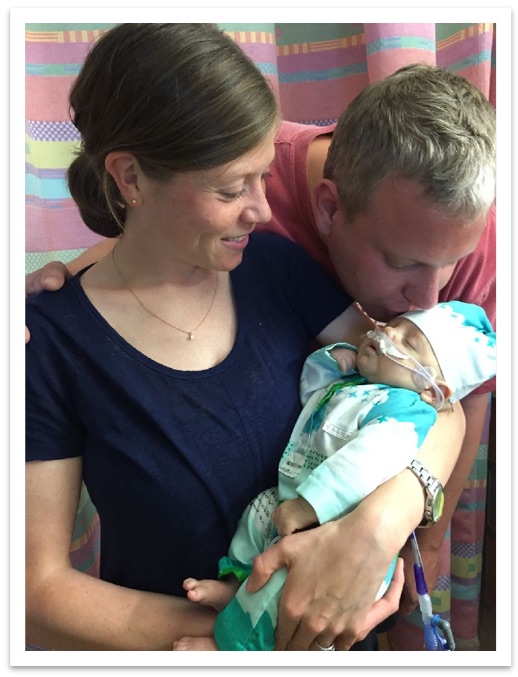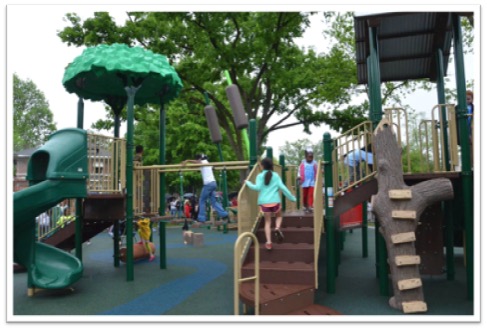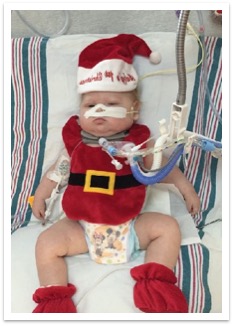“What do I do tomorrow?” This was the thought that Misti Staley had on the long car ride home after her 10-month-old son, Freeman, passed quietly away in the Arkansas Children’s Hospital PICU, the day after Valentine’s Day 2016.
She had been advocating for her medically complex son for so long, and she needed somewhere to put her grief, her nervous energy, and the long hours that made up the days. She was not ready to just go back to work for 8 hours and ‘return to normal.’ There would be no normal again. It was impossible. But there is always something else. This is what Freeman Ellis Staley’s legacy teaches her daily.
Misti Staley and her husband Will suffered a tragic loss that day. They had been fighting for almost a year, trying to stay ahead of Freeman’s multi-organ failure. There was always a new issue once he appeared like he was getting better. Born with a cleft palate in the back of his throat, Misti and Will immediately needed care for their newborn. As soon as that first hospital visit happened upon delivery, there would be weeks and months of treatments.
 Although there were multiple issues surrounding Freeman’s case, the first and probably most important one to remember is that he could not feed at all. He was given a feeding tube to get nourishment into his tiny body. First an OG (through the mouth), then an NG (through the nose) and eventually a gtube.
Although there were multiple issues surrounding Freeman’s case, the first and probably most important one to remember is that he could not feed at all. He was given a feeding tube to get nourishment into his tiny body. First an OG (through the mouth), then an NG (through the nose) and eventually a gtube.
The gtube is surgically placed directly into the stomach, and milk, formula, or sometimes a blended diet for older folks, is delivered straight to the stomach to start digestion. It’s common for many medically complex children, teenagers, and adults. At various times during Freeman’s short life, he also had many IVs, ECMO tubes to oxygenate his blood then return it to his body, and intubated for many months of his short life. Misti and Will spent more time in the hospital than at their home.
Freeman was fed by gravity syringe feeds during the day and pump feeds at night. While in the hospital, within all these tubes, wires, and technology, nurses hung the gravity syringe across the top of Freeman’s crib with a single cloth ribbon tied in a bow. That bow would come back to Misti as inspiration later.
The Playground
Misti and Will – staples in their community of Helena, Arkansas – held Freeman’s Celebration of Life ceremony and still wondered what would come next in their lives. During the event, the pastor mentioned that Misti and Will had considered building a playground in their community, but funding was enormous.
Misti and Will had discussed the idea of designing a playground but weren’t sure how to start. Friends and family started overhearing the talk of a playground and shared that they would donate. “I started the Freeman Foundation about a month after that,” says Misti. “Friends, family and strangers started donating to the foundation, but not just in Freeman’s memory,” she says. “Freeman Playground is in memory of all the children of Phillips County who have passed.”
Misti started raising money, designing a playground, and networking with state and city volunteers. She found out just how much a playground costs. “I wanted to make sure it was ADA accessible so all children could play,” she says. She worked with the company that installed the Arkansas Children’s Hospital playground where Freeman was treated. Misti applied for grants, had various fundraisers, and the playground opened a little more than a year after that initial conversation. It was the weekend of what would have been Freeman’s second birthday.
With a quarter-million dollars raised, the playground sits right off the Mississippi River and has a Delta theme. “It was fun to design,” says Misti. “I’m very thankful for Freeman Playground, it was a good, healthy way to grieve and gave me a reason to get out of bed in the morning.” Nothing is impossible when you feel someone cheering you on who is no longer with you. “I felt like Freeman was right there with me, saying ‘Go, momma, go!’”
The Next Big Thing: Creating The FreeArm
After the excitement of the playground started to settle, Misti says she felt the same nervousness she felt after Freeman’s death build back up again. “I wondered, now what? What do I do now? I still wasn’t ready to just get back to life as normal,” she remembers. Always in her mind and heart, she reflected on Freeman’s early days. She was a first-time mom who had a self-trained course in caring for a medically complex infant. Life was not easy.
“Will and I had chatted about creating a feeding tube holder for other parents and nurses when Freeman was in the PICU,” she remembers. “While in the hospital, I could always ask for help, for someone to hold the gravity syringe, or grab Freeman’s meds,” she says. But nurses cannot always stand at the bedside and hold the gravity syringe for every 3-hour feed. So they would rig it by taping it, or rubber banding it to the oxygen meter on the wall. Or they would tie the gravity syringe over the tall canopy crib with a ribbon.
“In the NICU and the PICU, the gravity syringe would always be rigged like this,” explains Misti. “And then, when we were discharged, I would have to figure out a way to replicate it at home to feed Freeman,” she says.

Misti explains that you need many arms while you are caring for a medically complex child. “You’ll be sitting on the couch at home trying to feed your child and hold the gravity syringe at the same time, but then you have to reach over to get the milk … but maybe you’ve forgotten the medicines, so you have to walk over to the other side of the kitchen to get them, all while you’re still holding your child and the gravity syringe,” she explains. There had to be a better way.
Will immediately went out to the garage and created the first of what would eventually become the FreeArm. It was two pieces of wood 1×1 with a hinge because it needed to move out of the way if Freeman started to aspirate and need immediate assistance.
This was a massive problem with the way that hospitals had been securing the gravity syringe. “When you tie a ribbon across the top of the crib, it’s in the way, and you can’t get to the patient quickly. Doctors and nurses were always fighting with the ribbon,” explains Misti.
Will and Misti didn’t realize it at the time, but they had just become inventors and would eventually create a tube feeding community that supported one another and cheered each other on. Fast forward three years, the couple had met with small business incubators and other innovators like themselves.
They designed prototypes alongside families and people who needed a feeding tube. They worked with other people who had suffered tragedies and saw a need that would make living easier. After much research and development, the production of the FreeArm was in full swing. Staley House LLC was born.
“Parents tell us that the FreeArm is a game-changer,” says Misti. Now free to explore the world, children and adults with a feeding tube can attach their FreeArm to a wheelchair or a stroller and go out and about to enjoy a better quality of life with mobility that hasn’t been possible before.

“Now, many hospitals are using the FreeArm with patients, then discharging the family home with the FreeArm. Hospitals can bill the FreeArm to the patient’s insurance,” she says. This way, new tube feeding families don’t have to rig the gravity syringe at home or feel constantly tethered to an IV pole. Gone are the dangerous ribbons across the crib.
Expanding the Reach
What’s next for Misti and Will? Their goal is to have the FreeArm supplied by more and more Durable Medical Equipment (DME) suppliers, but this takes time. As more families request the FreeArm from their DME, the more DMEs see the importance and quality of life that the FreeArm provides.
Both DMEs and hospitals can bill the FreeArm to customer’s and patient’s health insurance, and when the FreeArm is sent home with discharged families, this creates a smooth and easy transition from hospital to home.
Misti and Will suffered a tragedy, yes. But Misti says that she likes to believe Freeman is there with all the FreeArm users. #FreeArmFans post photos on social media, going to the zoo, playing in the park, enjoying life.
Yes, Freeman is there. His legacy lives on and will continue to help provide nourishment and freedom to thousands of people over. And maybe, just maybe, another new mom will be able to enjoy holding her son a bit easier.
If you’re interested in finding out more about the FreeArm, follow FreeArm Tube Feeding Assistant on Facebook, Instagram, and LinkedIn or buy the FreeArm directly from their website at freearmcare.com. For at-home customers, Staley House LLC has offered MGA clients a 15% discount on its FreeArm Muscle (enter coupon code MGA15 at checkout).
If you are a hospital or DME representative please send an emailed purchase order to info@freearmcare.com or order the FreeArm or FreeArm Muscle through Medline.
Thank you, Freeman for your legacy of love.

